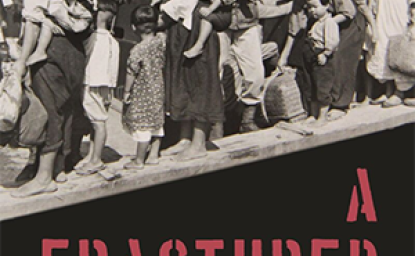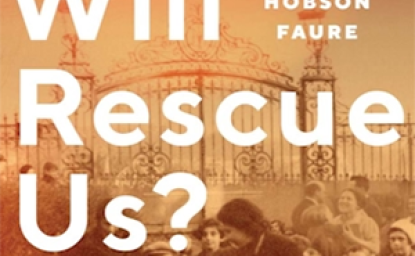Photo credit: USC Digital Library
In continuation of our alumni interview series, we talked with Title VIII-supported Research Scholar Alyssa Park to hear her reflections on her fellowship. Dr. Park has a PhD in History from Columbia University and is Assistant Professor at the University of Iowa. She is currently working on a project that traces the migration of Koreans to the Russian Far East and Manchuria in the nineteenth and twentieth centuries.
Malinkin: Tell us about the Chinese-Korean-Russian border in the 1860s — how rigid was it and how did it affect migration?
Park: A border has always existed between China and Korea, but it was a porous one with minimal regulation. People and goods flowed across, but officials were not inclined to care much. Why? The area was relatively uninhabited – it was designated as an off-limits buffer zone by Qing China and Chosŏn Korea – and the scale of movement was modest. Even as late as the mid-nineteenth century, it did not cross people’s minds to leave their hometown, much less leave their country. But in the 1860s, several factors converged to make the border an “institutionalized” place, that is, a rigid modern border that was governed by rules. The first is geopolitical and economic change: Russia began to develop its Far Eastern territories bordering on China and then Korea; and the Qing opened up the Manchurian frontier. The second is a change in the scale and nature of movement: Koreans, the most populous group in this tripartite region, started to pursue new opportunities abroad. They became landowners, tenant farmers, and seasonal laborers in mines and railroads across the Russian Far East and Manchuria. There was both permanent settlement and back-and-forth migration. And the third is a change in perception about borders, from the point of view of the state and people. The state, particularly Russia, suddenly starts to worry about the “massive flow” of people crossing its borders. It reacts by creating rules and institutions to govern the border, including customs points, passport control, citizenship laws, and even passes assimilationist policies inside its borders to distinguish Russians from Koreans, Chinese, and other unwanted aliens. The rules trickle down, but the consequences were mixed. The rules were created with the intention to keep out unwanted migrants, but they seemed only to increase the flow of migrants, enabling people to cross the border both legally and illegally (by buying fake passports, for example).
And what about Manchuria? Part of the region you study was considered Manchuria during this time period - how does Manchuria fit into the story?
Parts of today’s Russian Far East previously belonged to Qing China. The Qing and Russia came to an agreement about their land border through the 1689 Treaty of Nerchinsk. This was followed by the 1727 Treaty of Kyakhta. The border in the “far east,” that is, the area that opens onto the Pacific Ocean and touches Korea, however, was left ambiguous. My project deals with this ambiguous zone, a meeting place between Korea, Russia, China (and later Japan).
The Manchuria story provides a counterpoint to the Russian Far Eastern story, which plays a more prominent part in my project. Both were vast regions that were sparsely populated; those who lived there were primarily military populations, officials, and explorers/merchants. Both were part of vast empires that governed their territories loosely, by incorporating and tolerating (or, more accurately, ignoring) various traditions and peoples. I’m particularly interested in how the story of Korean migrants played out in these different milieu, how these governments responded to this group and to each other, and what this tells us about their understandings of identity and place.
There has been a lot of interest in the history of Manchuria. New scholarly work is being published as we speak. But briefly, the Qing (Manchu) government had imposed a prohibition on Han Chinese settlement in Manchuria because it considered the area the homeland of the Manchus. By preserving the Manchu homeland, the Qing hoped to preserve a Manchu identity and distinguish themselves from the people whom they had conquered, the Han Chinese. The area was also an imperial preserve, full of sable, ginseng, gold, and other resources that were designated as tribute for the Qing emperor. Apart from Manchus, indigenous nomadic peoples lived in this area. Much like the indigenous tribes of Siberia, their histories have largely been forgotten.
What happened in 1860? Why did you choose this as the beginning of your study?
In 1860, the last leg of the China-Russia border was clarified by the two countries through the Treaty of Beijing. The Qing lost the territory that opened up to the Sea of Japan (East Sea). Russia gained that territory and a brand new border with Korea. For Korea, this change is significant. Though it had no say in the matter, Korea gained a new neighbor: Russia was a state which was completely “Other” and lay outside East Asian/Confucian diplomatic and cultural norms. To me, this moment marks Korea’s entrance into the modern world. It is a moment that has been overlooked by most scholars, who point to the year 1876 (when Korea signed its first modern treaty with Japan) as the beginning of Korea’s “modern history.” This period also involved immense changes for all countries in the region.
So when the border became clearer in 1860 did more or fewer Korean migrants start going to that area?
Koreans had always been traveling in that area, but not in large numbers. No one was allowed to cross the border. According to the law, if you crossed the border you would be beheaded and your whole family would be made slaves. Leaving your country was tantamount to betraying your country.
What changes after 1860 is the scale of movement. Russia’s increased presence created new reasons to move: promises of land and opportunities to work short-term. The same process unfolded in Manchuria, where the Qing government became wary of Koreans going to Russia and, at times, welcomed them to Manchuria.
Were these mostly merchants? Farmers?
Merchants were the only group legally allowed to cross the border, at least the China-Korea border. There were also lots of people engaged in the illegal trade of ginseng, gold, timber, and other resources.
But the vast majority of people crossing the border to China and Russia were farmers. Many started out spending one or two farming seasons abroad and then returned to their hometown for the winter. After a while, they would stay abroad, send for their families, and eventually settle permanently outside Korea.
At what point did Russia go a step further and encourage the Koreans to populate these areas?
The tsarist government didn’t have a consistent policy toward Koreans. This was due to its conflicting goals. On the one hand, it wanted to populate and cultivate the area. On the other, it wanted to preserve security in an area where it was quite defenseless against its more powerful neighbors, mainly China (and later Japan). Korea, because of its historic ties to China, was seen as part of the “Chinese orbit.” So conflicting policies followed. We see similar kinds of debates in various countries all around the world at this time about how to develop frontier areas and who to use to develop them.
So their policy went back and forth on the Koreans but did there come a point when they thought that they could assimilate the Koreans? Russify them?
Yes, definitely, but the policy depended on whoever was in power at the time as well as the political climate. There are scholars who try to generalize what tsarist Russian officials thought about Koreans and their ability to assimilate to the Russian culture. For example, many records show that officials in the late nineteenth century believed Koreans were more “pliable” than Han Chinese or Buryats. But attitudes were by no means consistent. In fact, the binary between assimilability versus non-assimilability was the only consistent theme in discussions about Koreans, an issue which points to the internal difficulties of building a so-called “national” empire with a national mission. In the end, officials in St. Petersburg did not care that much and delegated these matters to local officials.
At different times, the Russian empire suspected the Koreans of siding either with the Chinese or the Japanese, depending on who was the bigger threat. During the period that you look at, were those fears were justified at any point?
It was the “Manzas,” not Koreans, who were a constant object of suspicion in the late nineteenth century. And justifiably so. “Manza” was the Russian name for “Manchus”; they were also known as “Red beards” for the color of their scarves. In spite of their name, the “Manzas” were ethnically diverse (Manchus, semi-nomadic peoples, Han Chinese, Koreans, and others). They were notorious for wreaking havoc on Russian and Korean villages in the Chinese-Russian-Korean border region. They also posed a problem for settlers in Manchuria itself. The Manzas stole from farms, kidnapped innocent people and even killed. If someone were to write a “Western” about this region, the Manzas would play the role of the lawless bandits.
Did the Russian state become suspicious of Koreans on its territory after 1910 (when Japan colonized Korea)? Weren’t they fearful that the Koreans would join forces with the Japanese?
There was a lot of debate about the Koreans in official Russian circles. There was no consensus about the political loyalties of Koreans: some believed that the Koreans sided with their new Japanese “overlords” and others that the Koreans hated the Japanese for taking over their country. The difference in opinion had as much to do with perception as with actual events. Korea was perceived as a malleable, weak power which would side with whatever country gained the upper hand. So some officials believed that the Koreans would side with Japan and some with Russia. In actuality, Koreans took matters into their own hands and had their own political leanings. During the Russo-Japanese War of 1904-5, the Korean guerrillas formed their own bands to fight against the Japanese, but fought on the side of the Russians. Later, they fought independently against the Japanese. Many were also mobilized by the ideas of communism and took the side of the Bolsheviks.
When was the peak of Korean migration to this area of Russia?
The peak was the 1920s. Koreans had become a reliable source of seasonal farm labor by this time. They had been going back and forth between Korea, the Russian Far East, and Manchuria. Migration was curtailed in 1931 when collectivization was implemented in the Far East. People were forced to register and became tied to the land. At this point, thousands of Koreans left Russia (now the Soviet Union).
You’ve talked about the difference between subjecthood and citizenship - how did that change during the period you study and how did that affect the people in these borderlands?
Both subjecthood and citizenship are defined as membership or belonging to a political body, the state. In the former, the focus is the subject’s personal obligations and ties to the ruler. The subject fulfills a set of obligations to the ruler and the ruler bestows privileges on him. In the Russian case, this meant swearing allegiance to the tsar and becoming Orthodox Christian. By contrast, citizenship focuses on the individual and individual rights. The idea of citizenship arises with the notion of the liberal state, in which people are no longer beholden to a perceived despotic ruler but are granted equal rights.
It is precisely one of the goals of my project to delve into the mutability and political weight of these terms. Subjecthood and citizenship are not neutral categories. They were created and used by states not only to define who belonged to their particular community but to define who did not belong. In the case of Koreans, subjecthood was used (by Russian officials) as a tool to impose a kind of class system upon the various Koreans who had made their way to the Russian Far East. Those who had subjecthood were desirable, while the vast majority who did not were deemed alien and dismissible.
At the same time, subjecthood became a political tool for states to use on the international stage. While Russia was using subjecthood as the basis to prevent masses of Korean migrants from entering into the country, it also used it as a means to claim Koreans outside Russia. For example, it deemed Korean-Russian expats in Seoul as under Russian jurisdiction. You can imagine the confusion that emerged among Qing, Chosŏn Korean, Japanese, and Russian diplomats. Korean migrants were crossing international borders on a daily basis.
There’s no pat answer to how subjecthood changes during this period. What I am interested in is how these different governments interpret it, use it, and try to come to a mutual understanding of it. In short, I show that international norms of these terms did not exist, but eventually come into being through adaptation of local and Western definitions.
What kinds of sources are you using?
Diplomatic correspondence is the most illuminating for such debates on subjecthood and citizenship. I am not talking about letters written by high-level ministers, but rather correspondence and reports by border officials who had their ear to the ground. Newspapers, ethnographies, government and church reports were also important for my research. These sources were taken from all three sides of the border: Russia, China, and Chosŏn Korea.
Bringing this up to the end of the period you study – tell us about the 1937 deportation of Koreans – were all Koreans in the Soviet Union targeted or just in certain areas? What happened with populations in the Far East? Did the policy change from wanting Koreans to populate those areas to deporting them?
These are very interesting questions because they lead to other concerns. But first let me answer your questions directly. Since most of the Koreans lived in the Far East, they were the target of the 1937 deportations. The Soviet government had decided that the Koreans – similar to other ethnic groups living in sensitive border regions – were a threat because of the Koreans’ purported ties to Japan as well as Japan’s claims on the Koreans. We have to remember that this is the period of Stalin’s Great Terror; everyone was suspect of plotting against the regime. It was also a time of political unrest in East Asia. In various stages, the NKVD transported about 180,000 Koreans in the Far East to the Central Asian republics.
But I try to put the deportation of 1937 in the context of larger resettlement policy in Russia. This is not to detract from the tragic nature of the event. Certainly, it was an injustice to the Koreans to be removed from their homes and many died on the long train ride. Some scholars have called this a purge, a kind of ethnic cleansing. But if you look at Russian settlement and migration policy from the mid-nineteenth century and even before, we can see that the deportation was just one of many instances of resettlement, albeit extreme. In a country as huge as the Russian empire, resettlement of entire groups of people was common. In the case of the Koreans, the tsarist government had been trying to resettle them away from the border region as soon as they had arrived in the 1860s. But with the constant stream of migrants, it was impossible to do. And in the end, it was easier to do nothing. That is, until the geopolitical climate necessitated action.
In the 1920s, under the Soviet nationalities policy of allowing the many ethnic groups to cultivate and practice their respective cultures and languages, there was actually talk of establishing a Korean autonomous province in the Far East. But it never materialized.
One day, I hope someone will do a comparative study of the Russian, Ottoman, and Qing empires, specifically about their views on borders, on resettlement/migration, and the impact on people and concepts of home and homeland. Much of the scholarship on migration and borders has centered on Europe, the Atlantic World, and white settler nations. What about these vast empires that were so huge and cosmopolitan that people did not need to leave but simply moved about within its borders? But I guess that scholars first need to tackle these questions within each empire. The story of borders in the tsarist empire as a whole has not yet been written. Now that more scholarship is being produced and archives are more accessible, I hope it is possible at least for Russia.







